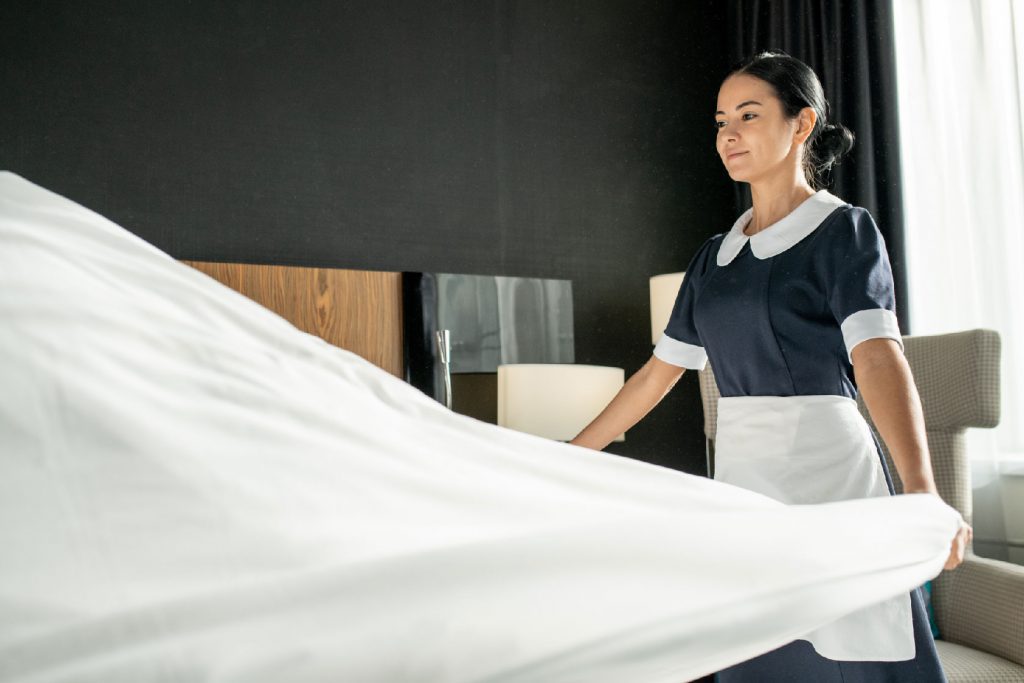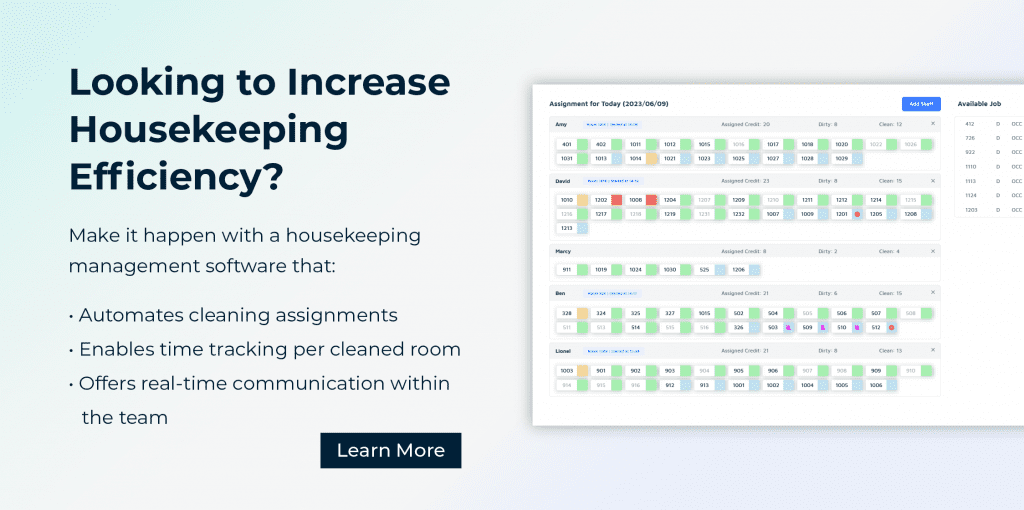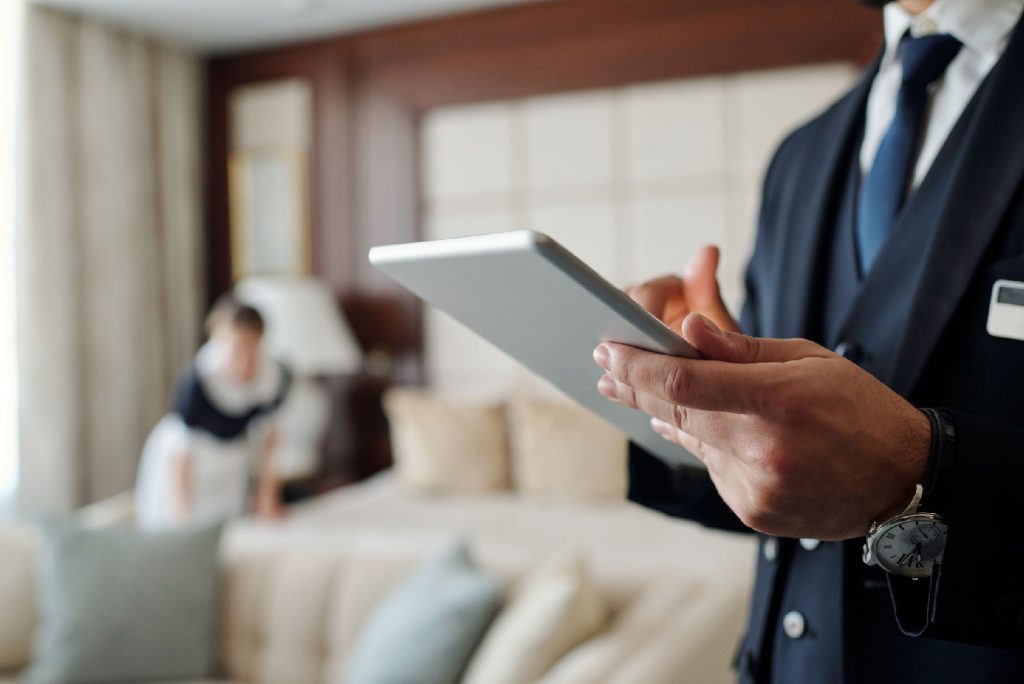
9 Important Housekeeping KPIs for Optimising Hotel Housekeeping Team
Housekeeping KPIs (Key Performance Indicator) are important indicators that hotel owners and hotel managers check regularly to ensure the housekeeping team is operating at its fullest potential. Tracking and analysing these indicators will help you identify areas that need improvement, and thus work on them to increase operational efficiency. This will also provide you with a deeper understanding of your own operations and insights on ways to save costs.
In this article, we will introduce 9 important KPIs, together with how they are calculated, for hotel housekeeping to ensure constant peak performance.
1. Occupany Rate
Occupancy Rate helps hotel owners and managers plan staffing and resources based on the hotel occupancy to maintain efficient operations.
How to calculate Occupancy Rate
OCC % = (# of occupied rooms ÷ # of available rooms) × 100
2. Average Room Turnaround Time
Average room turnaround time measures how quickly the room attendant can clean and prepare the room for the next guest after the previous occupant has checked-out. By minimising turnaround time, hotels can accommodate more guests within a specific timeframe, leading to higher occupancy rates and ultimately, increased revenue. Faster room preparation also ensures guests have a shorter wait time upon arrival, especially during peak check-in periods.
How to calculate Avg. Room Turnaround Time
Avg. Room Turnaround Time = Total time spent cleaning rooms ÷ Number of rooms cleaned
3. Rooms Per Attendant
Rooms Per Attendant is a metric used to help hotel managers know how many rooms a housekeeper needs to clean per shift. It is an important KPI that helps managers determine how many housekeepers they need to schedule per shift to ensure all rooms are cleaned efficiently and estimate labor costs associated with housekeeping operations. Tracking this KPI accurately can also help with fair performance evaluation for each attendant.
How to calculate Rooms Per Attendant
Rooms Per Attendant = # of rooms to be cleaned ÷ # of room attendants
4. Linen Utilisation Rate
Linen Utilisation Rate refers to a metric used to assess the efficiency of linen inventory management in hotels. When referring to linen in hotels, this includes bed, bath and restaurant or banquet table linen. By understanding linen usage patterns, hotels can optimise inventory levels, laundry services, and distribution processes – leading to smoother operations.
How to calculate Linen Utilisation Rate
Linen Utilisation % = (# of linen used ÷ # of linen available) × 100
5. Task Completion Rate
Besides cleaning rooms and getting them ready for the guests, the housekeeping team has other tasks that require their attention. These tasks might be ad hoc requests from guests, such as requesting for additional room amenities or light cleaning in the room, or housekeeping tasks from other departments.
Task Completion Rate helps the housekeeping manager measure the efficiency of the housekeepers and the time taken to complete each task. Tracking and analysing this metric can significantly enhance operational efficiency and ensure prompt guest service.
How to calculate Task Completion Rate
Task Completion % = (# of tasks completed ÷ # of tasks assigned) × 100
Tip: Use a mobile solution for the housekeeping team to receive and accept tasks on-the-go. Make sure the solution captures the right data to help meet your KPIs!
6. Room Inspection Scores
A room inspection score is a numerical value assigned to a room based on its condition after the turnaround by room attendant is done, assessed against a predefined set of criteria. This score serves as a quick and objective indicator of the room’s cleanliness, orderliness, and adherence to specific standards.
High inspection scores are naturally desired and low scores indicate issues that might negatively impact guests’ stay, potentially resulting in bad reviews and impacting the establishment’s reputation.
Regular inspections with a scoring system also hold housekeeping staff accountable for maintaining cleanliness and adhering to established protocols.
How to calculate Avg. Room Inspection Scores
Room inspection score = (Total score of all rooms inspected ÷ # of rooms inspected)
7. Guest Satisfaction Scores
Upon check-out, many hotels invite guests to share feedback through post-stay surveys. These surveys typically include questions covering the entirety of the guest experience, encompassing various touch points such as arrival, room and facility condition, and overall service.
Among these touchpoints, take note of guest satisfaction scores in areas of cleanliness which directly reflects the effectiveness of the housekeeping department. By paying close attention to guest feedback and suggestions regarding room cleanliness, hotels can gain valuable insights to optimise housekeeping operations and workflows.
How to calculate Guest Satisfaction Scores
Guest Satisfaction Scores = Total score ÷ # of respondents
8. Employee Satisfaction Scores
Employee Satisfaction Scores are a valuable tool for understanding employee sentiment across key areas like salary, benefits, work content, colleagues, work environment, and growth opportunities. Regularly collecting this feedback allows hotels to identify and address employee concerns, fostering a happier and more engaged workforce.
Some benefits of happy employees are reduced turnover, improved customer service and increased productivity.
How to calculate Employee Satisfaction Score
Employee Satisfaction Score = Total score from all staffs ÷ # of staffs
9. Employee Training Pass Rate
Investing in employee training and certification ensures your housekeeping team consistently meets the high standards expected by guests and the company’s brand. This approach empowers housekeepers to operate at peak performance by equipping them with the knowledge, skills, and work systems necessary to deliver exceptional service efficiently.
Additionally, you should prioritise continuous learning and development opportunities to cultivate expertise and maintain a competitive edge.
How to calculate Employee Training Pass Rate
Employee Training Pass Rate = (# of employees who passed the exam ÷ # of employees who took the exam) × 100
Conclusion
Tracking these 9 important Housekeeping KPIs and metrics must come with clear goals and evaluation cycles. Each KPI may have a different tracking cycle. Some may be weekly, others monthly, or even quarterly.
With every KPI, you should chart your course with data-driven precision and measurable goals. One such example would be setting a target such as average Room Turnaround Time to not exceed 30 minutes/room or average Room Inspection Scores should be above 9, etc.
When the housekeeping team has clear KPIs, hotel owners and managers can get deeper understanding and insights on how the housekeeping team can increase productivity based on actual data.
Are you looking for ways to maximise the efficiency of your housekeeping team? An operations optimisation solution will not only be able to help automate many of your manual processes, but also track some of the important KPIs mentioned in above.
Contact Vouch today for more information on the best housekeeping management system for hotels.

9 Important Housekeeping KPIs for Optimising Hotel Housekeeping Team
Housekeeping KPIs (Key Performance Indicator) are important indicators that hotel owners and hotel managers check regularly to ensure the housekeeping team is operating at its fullest potential. Tracking and analysing these indicators will help you identify areas that need improvement, and thus work on them to increase operational efficiency. This will also provide you with a deeper understanding of your own operations and insights on ways to save costs.
In this article, we will introduce 9 important KPIs, together with how they are calculated, for hotel housekeeping to ensure constant peak performance.
1. Occupancy Rate
Occupancy Rate helps hotel owners and managers plan staffing and resources based on the hotel occupancy to maintain efficient operations.
How to calculate Occupancy Rate
OCC % = (# of occupied rooms ÷ # of available rooms) × 100
2. Average Room Turnaround Time
Average room turnaround time measures how quickly the room attendant can clean and prepare the room for the next guest after the previous occupant has checked-out. By minimising turnaround time, hotels can accommodate more guests within a specific timeframe, leading to higher occupancy rates and ultimately, increased revenue. Faster room preparation also ensures guests have a shorter wait time upon arrival, especially during peak check-in periods.
How to calculate Avg. Room Turnaround Time
Avg. Room Turnaround Time = Total time spent cleaning rooms ÷ Number of rooms cleaned
3. Rooms Per Attendant
Rooms Per Attendant is a metric used to help hotel managers know how many rooms a housekeeper needs to clean per shift. It is an important KPI that helps managers determine how many housekeepers they need to schedule per shift to ensure all rooms are cleaned efficiently and estimate labor costs associated with housekeeping operations. Tracking this KPI accurately can also help with fair performance evaluation for each attendant.
How to calculate Rooms Per Attendant
Rooms Per Attendant = # of rooms to be cleaned ÷ # of room attendants
4. Linen Utilisation Rate
Linen Utilisation Rate refers to a metric used to assess the efficiency of linen inventory management in hotels. When referring to linen in hotels, this includes bed, bath and restaurant or banquet table linen. By understanding linen usage patterns, hotels can optimise inventory levels, laundry services, and distribution processes – leading to smoother operations.
How to calculate Linen Utilisation Rate
Linen Utilisation % = (# of linen used ÷ # of linen available) × 100
5. Task Completion Rate
Besides cleaning rooms and getting them ready for the guests, the housekeeping team has other tasks that require their attention. These tasks might be ad hoc requests from guests, such as requesting for additional room amenities or light cleaning in the room, or housekeeping tasks from other departments.
Task Completion Rate helps the housekeeping manager measure the efficiency of the housekeepers and the time taken to complete each task. Tracking and analysing this metric can significantly enhance operational efficiency and ensure prompt guest service.
How to calculate Task Completion Rate
Task Completion % = (# of tasks completed ÷ # of tasks assigned) × 100
Tip: Use a mobile solution for the housekeeping team to receive and accept tasks on-the-go. Make sure the solution captures the right data to help meet your KPIs!
6. Room Inspection Scores
A room inspection score is a numerical value assigned to a room based on its condition after the turnaround by room attendant is done, assessed against a predefined set of criteria. This score serves as a quick and objective indicator of the room’s cleanliness, orderliness, and adherence to specific standards.
High inspection scores are naturally desired and low scores indicate issues that might negatively impact guests’ stay, potentially resulting in bad reviews and impacting the establishment’s reputation.
Regular inspections with a scoring system also hold housekeeping staff accountable for maintaining cleanliness and adhering to established protocols.
How to calculate Avg. Room Inspection Scores
Room inspection score = (Total score of all rooms inspected ÷ # of rooms inspected)
7. Guest Satisfaction Scores
Upon check-out, many hotels invite guests to share feedback through post-stay surveys. These surveys typically include questions covering the entirety of the guest experience, encompassing various touch points such as arrival, room and facility condition, and overall service.
Among these touchpoints, take note of guest satisfaction scores in areas of cleanliness which directly reflects the effectiveness of the housekeeping department. By paying close attention to guest feedback and suggestions regarding room cleanliness, hotels can gain valuable insights to optimise housekeeping operations and workflows.
How to calculate Guest Satisfaction Scores
Guest Satisfaction Scores = Total score ÷ # of respondents
8. Employee Satisfaction Scores
Employee Satisfaction Scores are a valuable tool for understanding employee sentiment across key areas like salary, benefits, work content, colleagues, work environment, and growth opportunities. Regularly collecting this feedback allows hotels to identify and address employee concerns, fostering a happier and more engaged workforce.
Some benefits of happy employees are reduced turnover, improved customer service and increased productivity.
How to calculate Employee Satisfaction Score
Employee Satisfaction Score = Total score from all staffs ÷ # of staffs
9. Employee Training Pass Rate
Investing in employee training and certification ensures your housekeeping team consistently meets the high standards expected by guests and the company’s brand. This approach empowers housekeepers to operate at peak performance by equipping them with the knowledge, skills, and work systems necessary to deliver exceptional service efficiently.
Additionally, you should prioritise continuous learning and development opportunities to cultivate expertise and maintain a competitive edge.
How to calculate Employee Training Pass Rate
Employee Training Pass Rate = (# of employees who passed the exam ÷ # of employees who took the exam) × 100
Conclusion
Tracking these 9 important Housekeeping KPIs and metrics must come with clear goals and evaluation cycles. Each KPI may have a different tracking cycle. Some may be weekly, others monthly, or even quarterly.
With every KPI, you should chart your course with data-driven precision and measurable goals. One such example would be setting a target such as average Room Turnaround Time to not exceed 30 minutes/room or average Room Inspection Scores should be above 9, etc.
When the housekeeping team has clear KPIs, hotel owners and managers can get deeper understanding and insights on how the housekeeping team can increase productivity based on actual data.
Are you looking for ways to maximise the efficiency of your housekeeping team? An operations optimisation solution will not only be able to help automate many of your manual processes, but also track some of the important KPIs mentioned in above.
Contact Vouch today for more information on the best housekeeping management system for hotels.


